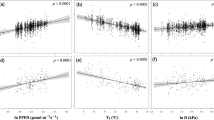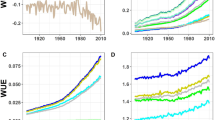Abstract
We revisit the relationship between plant water use efficiency and carbon isotope signatures (δ13C) of plant material. Based on the definitions of intrinsic, instantaneous and integrated water use efficiency, we discuss the implications for interpreting δ13C data from leaf to landscape levels, and across diurnal to decadal timescales. Previous studies have often applied a simplified, linear relationship between δ13C, ratios of intercellular to ambient CO2 mole fraction (C i/C a), and water use efficiency. In contrast, photosynthetic 13C discrimination (Δ) is sensitive to the ratio of the chloroplast to ambient CO2 mole fraction, C c/C a (rather than C i/C a) and, consequently, to mesophyll conductance. Because mesophyll conductance may differ between species and over time, it is not possible to determine C c/C a from the same gas exchange measurements as C i/C a. On the other hand, water use efficiency at the leaf level depends on evaporative demand, which does not directly affect Δ. Water use efficiency and Δ can thus vary independently, making it difficult to obtain trends in water use efficiency from δ13C data. As an alternative approach, we offer a model available at http://carbonisotopes.googlepages.com to explore how water use efficiency and 13C discrimination are related across leaf and canopy scales. The model provides a tool to investigate whether trends in Δ indicate changes in leaf functional traits and/or environmental conditions during leaf growth, and how they are associated with trends in plant water use efficiency. The model can be used, for example, to examine whether trends in δ13C signatures obtained from tree rings imply changes in tree water use efficiency in response to atmospheric CO2 increase. This is crucial for predicting how plants may respond to future climate change.




Similar content being viewed by others
References
Aranibar JN, Berry JA, Riley WJ, Pataki DE, Law BE, Ehleringer JR (2006) Combining meteorology, eddy fluxes, isotope measurements, and modeling to understand environmental controls of carbon isotope discrimination at the canopy scale. Glob Chang Biol 12:710–730
Arneth A, Lloyd J, Santruckova H, Bird M, Grigoryev S, Kalaschnikov YN, Gleixner G, Schulze E-D (2002) Response of central Siberian Scots pine to soil water deficit and long-term trends in atmospheric CO2 concentration. Glob Biogeochem Cycles 16 (1), doi: 10.1029/ 2000GB001374
Baldocchi DD, Bowling DR (2003) Modelling the discrimination of 13CO2 above and within a temperate broad-leaved forest canopy on hourly to seasonal time scales. Plant Cell Environ 26:231–244
Ball JT, Woodrow IE, Berry JA (1987) A model predicting stomatal conductance and its contribution to the control of photosynthesis under different environmental conditions. In: Biggins I (ed) Progress in Photosynthesis Research, vol. IV. Proc Int Congr Photosynthesis. Martinus Nihjoff, Dordrecht, pp 221–224
Beerling DJ (1994) Predicting leaf gas exchange and δ13C responses to the past 30,000 years of global environmental change. New Phytol 128:425–433
Bernacchi CJ, Leakey ADB, Heady LE, Morgan PB, Dohleman FG, McGrath JM, Gillespie KM, Wittig VE, Rogers A, Long SP, Ort DR (2006) Hourly and seasonal variation in photosynthesis and stomatal conductance of soybean grown at future CO2 and ozone concentrations for 3 years under fully open-air field conditions. Plant Cell Environ 29:2077–2090
Bert D, Leavitt SW, Dupouey JL (1997) Variations of wood δ13C and Water-use efficiency of Abies alba during the last century. Ecology 87:1588–1596
Brooks A, Farquhar GD (1985) Effect of temperature on the CO2/O2 specificity of ribulose 1,5-bisphosphate carboxylase oxygenase and the rate of respiration in the light: estimates from gas exchange measurements on spinach. Planta 165:397–406
Cernusak LA, Aranda J, Marshall JD, Winter K (2007) Large variation in whole-plant water-use efficiency among tropical tree species. New Phytol 173:294–305
Collatz GJ, Ball JT, Grivet C, Berry JA (1991) Physiological and environmental regulation of stomatal conductance, photosynthesis and transpiration: a model that includes a laminar boundary layer. Agric For Meteorol 54:107–136
Condon AG, Richards RA, Rebetzke GJ, Farquhar GD (2004) Breeding for high water-use efficiency. J Exp Bot 55:2447–2460
Cowan IR, Farquhar GD (1977) Stomatal function in relation to leaf metabolism and environment. Symp Soci Exp Biol 31:471–505
Craig H (1953) The geochemistry of the stable carbon isotopes. Geochim Cosmochim Acta 3:53–92
De Lucia EH, Whitehead D, Clearwater MJ (2003) The relative limitation of photosynthesis by mesophyll conductance in co-occurring species in a temperate rainforest dominated by the conifer Dacrydium cupressinum. Funct Plant Biol 30:1197–1204
Duquesnay A, Breda N, Stievenard M, Dupouey JL (1998) Changes of tree-ring δ13C and water-use efficiency of beech (Fagus sylvatica L.) in north-eastern France during the past century. Plant Cell Environ 21:565–572
Ehleringer JR, Cerling TE (1995) Atmospheric CO2 and the ratio of intercellular to ambient CO2 concentrations in plants. Tree Physiol 15:105–111
Evans JR, von Caemmerer S (1996) Carbon dioxide diffusion inside leaves. Plant Physiol 110:339–346
Farquhar GD (1983) On the nature of carbon isotope discrimination in C4 species. Aust J Plant Physiol 10:205–226
Farquhar GD, Richards RA (1984) Isotopic composition of plant carbon correlates with water use efficiency of wheat genotypes. Aust J Plant Physiol 11:539–552
Farquhar GD, Caemmerer von S, Berry JA (1980) A biochemical model of photosynthetic C02assimilation in leaves of C3 species. Planta 149:78–90
Farquhar GD, O’Leary MH, Berry JA (1982) On the relationship between carbon isotope discrimination and the intercellular carbon dioxide concentration in leaves. Aust J Plant Physiol 9:121–137
Farquhar GD, Ehleringer JR, Hubick KT (1989) Carbon isotope discrimination and photosynthesis. Ann Rev Plant Physiol Plant Mol Biol 40:503–537
Feng X (1998) Long-term c I/c a response of trees in western North America to atmospheric CO2 concentration derived from carbon isotope chronologies. Oecologia 117:19–25
Flexas J, Diaz-Espejo A, Galmés J, Kaldenhoff R, Medrano H, Ribas-Carbo M (2007) Rapid variations of mesophyll conductance in response to changes in CO2 concentration around leaves. Plant Cell Environ 30:1284–1298
Francey RJ, Allison CE, Etheridge DM, Trudinger CM, Enting IG, Leuenberger M, Langenfelds RL, Michel E, Steele LP (1999) A 1,000-year high precision record of δ13C in atmospheric CO2. Tellus 51B:170–193
Ghashghaie J, Duranceau M, Badeck F-W, Cornic G, Adeline M-T, Deleens E (2001) δ13C of CO2 respired in the dark in relation to δ13C of leaf metabolites: comparison between Nicotiana sylvestris and Helianthus annuus under drought. Plant Cell Environ 24:505–515
Ghashghaie J, Badeck F, Lanigan G, Nogues S, Tcherkez G, Deleens E, Cornic G, Griffiths H (2003) Carbon isotope fractionation during dark respiration and photorespiration. Phytochem Rev 2:145–162
Gillon JS, Griffiths H (1997) The influence of (photo) respiration on carbon isotope discrimination in plants. Plant Cell Environ 20:1217–1230
Griffiths H, Borland AM, Gillon JS, Harwood KG, Maxwell K, Wilson JM (1999) Stable isotopes reveal exchanges between soil, plants and the atmosphere. In: Press MC, Scholes JD, Barker MG (eds) Advances in physiological plant ecology. Blackwell Science, Oxford, pp 415–441
Guy RD, Fogel ML, Berry JA (1993) Photosynthetic fractionation of the stable isotopes of oxygen and carbon. Plant Physiol 101:37–47
Hemming D, Yakir D, Ambus P, 31 co-authors (2005) Pan-European δ13C values of air and organic matter from forest ecosystems. Glob Chang Biol 11:1065–1093
Katul GG, Ellsworth DS, Lai C-T (2000) Modelling assimilation and intercellular CO2 from measured conductance: a synthesis of approaches. Plant Cell Environ 23:1313–1328
Lauteri M, Scartazza A, Guido MC, Brugnoli E (1997) Genetic variation in photosynthetic capacity, carbon isotope discrimination and mesophyll conductance in provenances of Castanea sativa adapted to different environments. Funct Ecol 11:675–683
Le Roux X, Bariac T, Sinoquet H, Genty B, Piel C, Mariotti A, Girardin C, Richard P (2001) Spatial distribution of leaf water-use efficiency and carbon isotope discrimination within an isolated tree crown. Plant Cell Environ 24:1021–1032
Li C, Liu S, Berninger F (2004) Picea seedlings show apparent acclimation to drought with increasing altitude in the eastern Himalaya. Trees 18:277–283
Lloyd J (1991) Modelling stomatal responses to environment in Macadamia integrifolia. Aust J Plant Physiol 18:649–660
Lloyd J, Farquhar GD (1994) 13C discrimination during CO2 assimilation by the terrestrial biosphere. Oecologia 99:201–215
Lloyd J, Syvertsen JP, Kriedemann PE, Farquhar GD (1992) Low conductances for CO2 diffusion from stomata to the sites of carboxylation in leaves of woody species. Plant Cell Environ 15:873–899
Loader NJ, Robertson I, McCarroll D (2003) Comparison of stable carbon isotope ratios in the whole wood, cellulose and lignin of oak tree-rings. Palaeogeogr Palaeoclimatol Palaeoecol 196:395–407
Marshall JD, Monserud RA (1996) Homeostatic gas exchange parameters inferred from 13C/12C in tree rings of conifers. Oecologia 105:13–21
McCarroll D, Loader NJ (2004) Stable isotopes in tree rings. Q Sci Rev 23:771–801
Monti A, Brugnoli E, Scartazza A, Amaducci MT (2006) The effect of transient and continuous drought on yield, photosynthesis and carbon isotope discrimination in sugar beet (Beta vulgaris L. ). J Exp Bot 57:1253–1262
Mook WG, Bommerson JC, Staverman WH (1974) Carbon isotope fractionations between dissolved bicarbonate and gaseous carbon dioxide. Earth Planet Sci Lett 22:169–176
O’Leary MH (1981) Carbon isotope fractionation in plants. Phytochemistry 20:553–567
O’Leary MH (1984) Measurement of the isotopic fractionation associated with diffusion of carbon dioxide in aqueous solution. J Phys Chem 88:823–825
Osmond CB, Björkman O, Anderson DJ (1980) Physiological processes in plant ecology. Springer, New York
Peñuelas J, Azcón-Bieto J (1992) Changes in leaf Δ13C of herbarium plant species during the last 3 centuries of CO2 increase. Plant Cell Environ 15:485–489
Ponton S, Dupouey J-L, Breda N, Feuillat F, Bodenes C, Dreyer E (2001) Carbon isotope discrimination and wood anatomy variations in mixed stands of Quercus robur and Quercus petraea. Plant Cell Environ 24:861–868
Rajabi A (2006) Carbon isotope discrimination and selective breeding of sugar beet (Beta vulgaris L.) for drought tolerance. PhD thesis, University of Cambridge, UK
Robertson A, Overpeck J, Rind D, Mosley-Thompson E, Zielinski G, Lean J, Koch D, Penner J, Tegen I, Healy R (2001) Hypothesized climate forcing time series for the last 500 years. J Geophys Res 106:14783–14803
Roeske CA, O’Leary MH (1984) Carbon isotope effects on the enzyme-catalyzed carboxylation of ribulose bisphosphate. Biochemistry 23:6275–6284
Rooney MA (1988) Short-term carbon isotope fractionation by plants. PhD thesis, University of Wisconsin, Madison
Saurer M, Siegwolf RTW, Schweingruber FH (2004) Carbon isotope discrimination indicates improving water-use efficiency of trees in northern Eurasia over the last 100 years. Glob Chang Biol 10:2109–2120
Tcherkez G, Cornic G, Bligny R, Gout E, Ghashghaie J (2005) In vivo respiratory metabolism of illuminated leaves. Plant Physiol 138:1596–1606
Vitousek PM, Field CB, Matson PA (1990) Variation in foliar δ13C in Hawaiian Meterosideros polymorpha: a case of internal resistance? Oecologia 84:362–370
Warren CR (2004) The photosynthetic limitation posed by internal conductance to CO2 movement is increased by nutrient supply. J Exp Bot 55:2313–2321
Warren CR, Adams MA (2006) Internal conductance does not scale with photosynthetic capacity: implications for carbon isotope discrimination and the economics of water and nitrogen use in photosynthesis. Plant Cell Environ 29:192–201
Warren CR, Dreyer E (2006) Temperature response of photosynthesis and internal conductance to CO2: results from two independent approaches. J Exp Bot 57:3057–3067
Wingate L, Seibt U, Moncrieff JB, Jarvis PG, Lloyd JJ (2007) Variations in 13C discrimination during CO2 exchange by Picea sitchensis branches in the field. Plant Cell Environ 30:600–616
Wullschleger SD (1983) Biochemical limitations to carbon assimilation in C3 plants—a retrospective analysis of the A/C I curves from 109 species. J Exp Bot 44:907–920
Acknowledgements
The development of the model was inspired by the ESF/SIBAE Workshop on “Stable Isotopes in Dendroclimatology”, GFZ Potsdam, Germany, February 2007. We thank Gerd Helle and the participants of the workshop for discussions. We also thank Eric S. Ober for support. We are grateful to the two reviewers for helpful comments and suggestions. US was funded by a Marie Curie Fellowship of the European Commission (contract MOIF-CT-2004-2704).
Author information
Authors and Affiliations
Corresponding author
Additional information
Communicated by Russell Monson.
Electronic supplementary material
Below is the link to the electronic supplementary material.
Appendix
Appendix
Rights and permissions
About this article
Cite this article
Seibt, U., Rajabi, A., Griffiths, H. et al. Carbon isotopes and water use efficiency: sense and sensitivity. Oecologia 155, 441–454 (2008). https://doi.org/10.1007/s00442-007-0932-7
Received:
Accepted:
Published:
Issue Date:
DOI: https://doi.org/10.1007/s00442-007-0932-7




